JOTS v36n1 - Using Motorsports Design Concepts to Further STEM Education
Using Motorsports Design Concepts to Further STEM Education
Pete Hylton
Abstract
Few career paths are as dynamic, exciting, and engaging to potential Science, Technology, Engineering and Math (STEM) students as those in motorsports. Secondary school students, looking forward to their initial driver’s licenses and their first cars, are captivated by the speed and color of the sport. Indiana University Purdue University Indianapolis (IUPUI), which offers the first Bachelor’s Degree in Motorsports Engineering in the United States, has found motorsports to be an excellent mechanism for attracting STEM students, of both genders, regardless of demographic background. This article will discuss how this connection has been used to promote STEM growth.
Introduction
IUPUI has developed a program involving both Motorsports Engineering ( Hylton, 2008 ) and Motorsports Engineering Technology ( Hylton, 2007 ). With the rapid growth of academic motorsports programs, and the demonstrated interest by secondary school students who are investigating potential collegiate programs, it became clear that use of the technologies involved in motorsports was an excellent mechanism for engaging these students in STEM education.
Concepts related to driving a race car or working on one were initially developed as components of broader pre-engineering curriculum modules associated with a summer camp ( Campbell & Hylton, 2005 ) for students from low socioeconomic status and minority households. The concept of the friction circle, as shown in Figure 1, was introduced as a means of determining the limits of a car’s ability to travel around a corner at speed. The circle represents the limit of traction force that a race tire can supply. The tire’s capabilities can be used to supply forward acceleration, braking deceleration, lateral acceleration during cornering, or a combination of these. However, there is a limit to the traction force available from the tire, which results from its friction coefficient and the portion of the vehicle load that it is carrying. This limit is represented by the circumference of the circle. The vector combination of the forces on the tire cannot exceed the overall limit of the tire’s capabilities. Thus when the fore-aft (acceleration or deceleration) and lateral (sideways) force vectors are combined, the resultant must stay within the circle. Covertly, the objective of introducing the friction circle into the classroom module was to demonstrate the concept of vector math and to instruct students on how to use it. By using the theme of motorsports as a conveyance of STEM topics, the material was readily accepted by the students and they rose to the challenge.
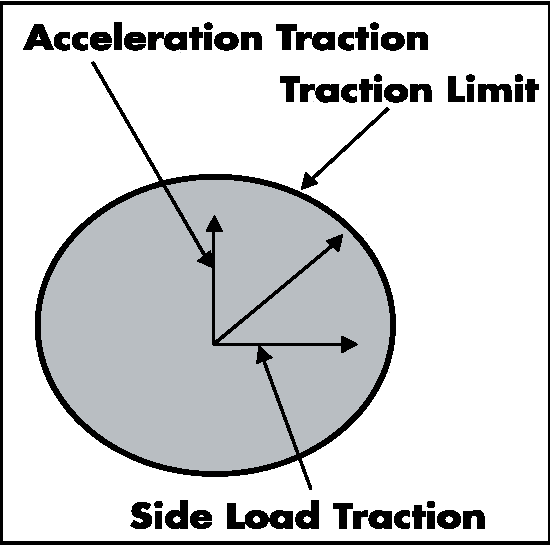
Motorsports Concepts In Curriculum
In another example, students were challenged to develop an understanding of forces, couples, and moment arms. A torque wrench, like that used by the mechanics on a racecar, was utilized. This gave the students an opportunity to see how work was completed on the university’s racecar. In addition, it provided the opportunity for students to see how the angle of application of a force, and the resulting moment arm, affect the amount of torque created by a given force application. The ability to use a mechanical advantage to lift a car via a purely mechanical jack used by many race teams was also incorporated into these classroom modules. Also, for female students who had difficulty realizing that sometimes male students are physically stronger, this showed that (with help) even the smallest female student in the class could lift an object that was too heavy for the strongest male student. This was used as a positive reinforcing reinforcement activity ( Hylton, 2006 ).
The lesson plans of the summer camp, which included concepts mentioned in the previous paragraph was extremely successful ( Otoupal & Hylton, 2007 ). The camp also demonstrated that these topics are not attractive exclusively to Caucasian males. In fact, a high percentage of female and minority students were also interested by these modules ( Otoupal & Hylton, 2006 ). This led to the development of a longer curriculum module, which could be extended from a few days to several weeks, which was aimed at both involving students in a motorsports related design project that could be tied to additional concepts from science and mathematics.
Motorsports Safety Structure Design
During the last decade, safety has been the area of greatest advancement in motorsports; partly it was the result of the loss of two of the sport’s best-known drivers: seven-time National Association for Stock Car Auto Racing (NASCAR) champion, Dale Earnhardt Sr. and three-time Formula One World Champion, Ayrton Senna. As racecars have become faster, they also carry more and more kinetic energy that must be dissipated when a crash occurs. Extensive effort has been expended into designing and developing systems to absorb or distribute the energy that occurs during a crash in order to protect the driver. Some of these concepts also have been adapted to increase the safety of the average driver on the street.
Areas of safety that have seen extensive development include driver’s personal safety equipment, (e.g., a variety of head and neck restraints) and energy-absorbing racetrack barriers. These approaches are discussed in a new module regarding how STEM practitioners have applied their skills to developing safer racing practices. The topic used to develop a design project for students (grades 6-12) was “energy-absorbing vehicle structures” ( Hylton, 2009 ). For all drivers in the top racing series (e.g., the Formula One Grand Prix Circuit, Indy Cars that compete in Indianapolis 500, and the Car of Tomorrow (COT) stock cars which compete in the top NASCAR series) the use of energy-absorbing structures has become key to keeping them safe.
Learning From Previous Crashes
A great demonstration of the benefits resulting from energy-absorbing safety structures can be seen in Michael McDowell’s qualifying crash at the Texas Motor Speedway in 2008. McDowell lost control of his car and crashed head-on into the outer retaining barrier of the track at an estimated 165 mph. Although the car was destroyed, as shown in Figure 2 ( SpeedTV, 2008 ), he managed to walk away, and less than 24 hours later he qualified for the same race in another car. This crash is noticeably more severe than the crash that killed Dale Earnhardt (only a few years earlier). The difference in severity in the two crashes is immediately obvious to the students who are exposed to this motorsports safety material.
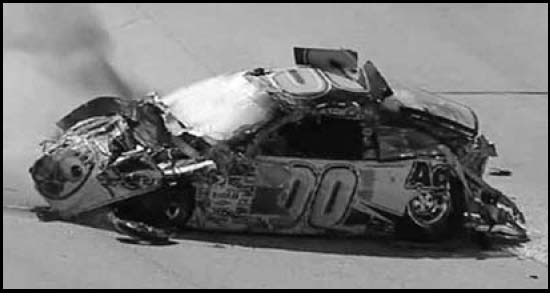
This discussion opens the door to several STEM concepts, beginning with a discussion of kinetic energy, which is equal to one-half mass times velocity squared. Students are asked to consider how the ever-increasing speeds of racecars have made it more challenging to protect the driver because of the increase in the vehicle’s energy. The fact that applied work can offset energy is introduced in the context of the Law of Conservation of Energy. Work is calculated from an applied force over a distance. Students are asked to consider a way to examine the post-crash remnants of McDowell’s car and estimate the force of the impact. With a little guidance, they recognize that the car is noticeably shorter after the crash. The crash resulted in a significant shortening of the front end of the car. Additionally, a review of the crash film shows deformation of the safer barrier wall that the car hit. The sum of the distance the wall deflected and the distance the center of gravity of the car moved during the shortening of the chassis can be used to estimate the distance over which the impact force was applied. Mathematical problem-solving skills are then exercised to estimate the amount of force that the car experienced during the crash. This is the sort of connectivity between real-world issues, science concepts, and mathematics skills that have previously piqued the interest of secondary school students and helped them appreciate their math and science training ( Otoupal & Hylton, 2005 ). As a result, students improved in both their understanding of simple engineering technology concepts as well as their execution of math and science related problem-solving skills ( Otoupal & Hylton, 2009 ). This is one of the main objectives of improving STEM education.
Project To Reinforce Energy-Absorbing Concepts
By performing parametric studies examining the results of this process, students can clearly see how the force that must be absorbed by the vehicle is related to the “crushability” of the structure. In other words, if the car can be intentionally designed to crush in a controlled manner during a crash, the structure is capable of absorbing more energy, thus reducing the forces transmitted to the occupant’s body. Students are then given the objective of a designing their own energy-absorbing concept for a crash-test vehicle. The need to conceptualize, design, fabricate, and construct a vehicle capable of protecting a passenger (in this case an egg) during a severe impact, is a challenge that they can easily relate to after discussions that have been described in this article. Armed with the new-found understanding of how motorsports safety structures are designed, students are provided with simple construction materials (e.g., balsa wood, poster board and glue). In addition, they have access to a test cart, which will carry their structures down the crash-test track. They are also supplied the egg that will serve as a fragile passenger during the testing.
Once completed the crash-test vehicles built by the students are sent down a sloped track, allowing them to convert potential energy at the top of the hill to kinetic energy at the bottom (another tie to appropriate science concepts), as shown in Figure 3. Results are readily obvious, because a successful design yields an intact driver (egg) after the crash, as shown in Figure 4. A less successful design fails to provide adequate energy absorption and results in an injured passenger, or in this case, a broken egg, as shown in Figure 5. For obvious reasons, this testing should be done outdoors.
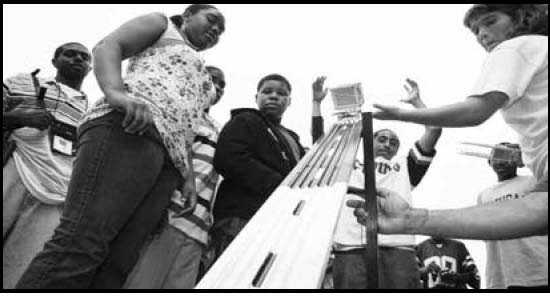
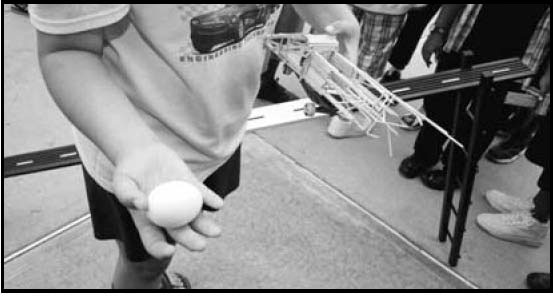
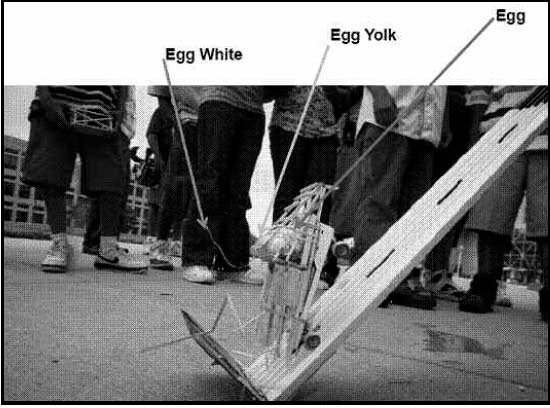
Conclusions
- After using motorsports-related educational modules in more than a dozen situations of various lengths and at various secondary school grade levels, the material has proven to be consistently popular with the student participants.
- Assessment results from activities using these motorsports-related modules have indicated an increase in both awareness of STEM activities and careers, and growth in basic science and math skills.
- When presenting elements of this work to secondary school teachers via STEM workshops, the teachers have consistently indicated that the material would be easy to present in either a classroom or summer camp environment, even if they had no particular previous motorsports expertise.
- Secondary school teachers have shown a strong belief that their students would react positively to the use of these motorsports-related materials in the classroom, which is capable of reaching across both gender and demographic lines.
- Motorsports-related activities are an excellent way to connect with potential STEM students and assist them, through experiential learning, to further their math, science, design, and problem-solving skills.
Recommendations
- Motorsports provides an exciting avenue for connecting students to STEM concepts and careers, but it has been mostly overlooked by the academic community. Based on the results of the modules developed at IUPUI, it is recommended that STEM educators consider integrating motorsports-based activities into their classroom.
- The developers of these modules have disseminated information on the project to secondary school math and science teachers in only a localized area surrounding the university. It is recommended that mechanisms for broader dissemination be pursued.
- As recommendations 1 and 2 are completed, it is recommended that a more thorough, and statistically based, analysis of student results be undertaken.
Dr. Pete Hylton is an Associate Professor in the Mechanical Engineering Technology Department at Indiana Univ. Purdue Univ. at Indianapolis.
References
Campbell, W. & Hylton, P. (2005, October) Teaming for the future with Purdue’s Science Bound Initiative: A cooperative program involving university, secondary schools, and local industries to increase diversity in engineering and technology programs. Proceedings of the 2005 Frontiers in Education Conference . Indianapolis, Indiana.
Hylton, P. (2006, June) Teaching math with real world correlation. ASEE Workshop on K-12 Engineering Education, 2006 ASEE National Convention , Chicago, IL.
Hylton, P. (2007, March) Let’s go racing: Constructing a collegiate motorsports program, Proceedings of the 2007 ASEE IL/IN Section Conference , Indianapolis, IN.
Hylton, P. (2008, September) Guest editorial: Students and careers in motorsports. Manufacturing Engineering.
Hylton, P. (2009, August) Integrating motorsports into secondary education. PRISM Workshop, Rose-Hulman Institute of Technology, Terre Haute, IN.
Otoupal, W. & Hylton, P. (2005, September). Coupling math and engineering concepts in a K-12 classroom environment. Proceedings of the 2005 ASEE/AaeE Global Colloquium. Sydney, Australia.
Otoupal, W. & Hylton, P. (2006, June). Improving skills and attitudes in minority females training for engineering and technology careers. Proceedings of the 2006 WEPAN Conference. Pittsburgh, PA.
Otoupal, W. & Hylton, P. (2007, October). Stratification of attitudes and skill level as correlated with knowledge and self-confidence in a pre-engineering curriculum. Proceedings of the 2007 Frontiers in Education Conference , Milwaukee, WI.
Otoupal, W. & Hylton, P. (2009, Summer) Engaging secondary school students in pre-engineering studies to improve skills and develop interest in engineering careers. The International Journal of Engineering Education.
SpeedTV. (2008) [Photo illustration of the Michael McDowell, Texas Motor Speedway crash, 2008]. Retrieved 1/15/10 from http://nascar.speedtv.com/article/cup-video-big-qualifying-crash.